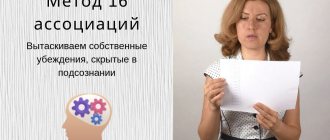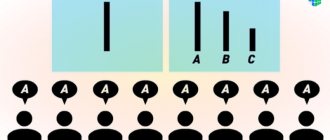The free association method, also known as the association experiment, is a psychoanalytic procedure for exploring the unconscious. As the experiment progresses, the subject calmly voices everything that comes to his mind, not paying attention to the absurdity and obscenity of the thoughts. This method is widely used in psychology, psychiatry, psychoanalysis, sociology and a number of other areas.
Story
The method of free association or associative experiment was first used by Francis Galton and Wilhelm Wundt in the 80s of the 19th century to study mental processes. At the beginning of the twentieth century, E. Kraepelin, Z. Freud and K. Jung began to use it in psychiatry to study the unconscious. The essence of the method in this case was a quick spontaneous response with the first word that came to mind to the presented “word-stimulus”. The universality of associative processes was the reason for the applied use of this method in the 70s of the twentieth century in management, business, advertising and inventive creativity.
Method functions
1. The association method can be an effective way to creatively solve problems and find new solutions, and can also be used to identify all possible signs and properties of the object under study. 2. It can be considered as a heuristic technique used to get rid of traditional, stereotypical connections, undermine stereotypes, develop a completely new view of the problem and achieve originality, freshness, surprise of ideas and solutions. 3. The method of associations acts as a way to expand the semantic space of a problem, obtain unexpected images, concepts and meanings, and highlight new possibilities. 4. The method acts as a way to awaken fantasy and imagination, activate creative thinking in solving various applied problems.
The essence and purpose of the method
The essence of the method is to find as many distant and unexpected associations as possible to the object or problem under consideration and create new connections between these associations and the original object. Creating semantic connections between a problem and an associative object (concept, image, feeling, phenomenon or process) found in various ways is a means of discerning and finding an analogy, which contains a creative idea. The use of the method allows you to break old connections, destroy stereotypes, highlight new contests and thereby build a bridge to analogies, which act as powerful generators of new ideas. It is the analogies found with the help of associative connections that contain the most powerful, fresh and unexpected solutions.
Methodological and theoretical foundations of the method
Fundamental principles 1. The principle of universal connection , community and unity of all objects and phenomena of the world. Everything is connected to everything. Associative connections are global in nature and arise between any objects that have any common characteristics. Any word can generate in the mind a limitless system of connections and relationships. 2. The principle of universality of the basic laws and structures of creativity. Creative mechanisms and operating principles of one field of activity are transferred to another. 3. The principle of inexhaustibility and endless wealth of the world. The world is wider, richer and more diverse than we see and what it seems to us. A word - a stimulus - generates a limitless system of connections in our minds, awakening the most diverse and unexpected images. 4. The principle of pragmatism. The whole world appears as a resource: everything can be useful, we have the entire Universe at our disposal. 5. The principle of unity of the conscious and the unconscious , subconscious creative activity. Associations are ways of spontaneous generation of unconscious content, bridges, transition zones between conscious and subconscious processes. Associative thinking is carried out with disabled or delayed logical analysis.
Theoretical foundations Association is understood as a reflection in human consciousness of the relationship between objects of reality and mental ideas, concepts, sensations, perceptions, experiences, motor acts, in which one idea of an object gives rise to another, similar to it. The stimulus object for generating associations can be any objects in the surrounding world: randomly selected words, symbols, pictures, melodies. At the internal, mental level, associations are understood as connections between individual ideas, in which one of the ideas causes another, and at the psychophysiological level - as a conditioned reflex. Associations appear without active perception, spontaneously and without logical evaluation. The strength, originality and brightness of associations depends on the richness of a person’s inner world, experience, orientation and his individual characteristics. Discovery and establishment of new associative connections. In the process of the emergence of associations, extraordinary relationships are established between the object being improved or the problem being solved and randomly selected elements of the external world and the internal world, including the contents of EXPERIENCE. When discovering or creating new associative connections, the consciousness and subconscious of a person begins to generate new ideas. The very process of discovery and birth of new associative connections and finding new analogies leads to the creation of original ideas and creative solutions to the problem. Thus, the following creative chain is created: a problem or an object being improved - a word found using free associations - the discovery of a connection between the problem and this word - the creation of an analogy - the birth of an original idea. Creativity is understood as the connection of distant phenomena, concepts and meanings, types of activities, different worlds and spheres of reality. At the same time, using useful functional analogies based on the created connections, allows you to transfer operating principles, successful methods of action and methods of solving problems from familiar worlds to newly discovered ones.
Types of associations
To find associations, there are several ways to build associative links between any objects:
- Contiguity in time or space: table and chair, winter and snow;
- Similarity (similarity): earth and ball, lamp and pear;
- Contrast (opposite): good and evil, black and white;
- Causal relationships: thunder and lightning, lamp and light;
- Generalization: tomato and vegetable, dog and animal;
- Submission: vegetable and cucumber, animal and cat;
- Subordination to one object: car and motorcycle;
- Part and whole: seconds and minutes, car and engine;
- Addition: toothpaste and toothbrush.
Depending on the application of these methods, as well as on various modifications and conditions of their use, different types of associations can be found. For example, associations are:
- thematic, in which objects are related to a single theme (marketing and advertising);
- phonetic, in which there is consonance between objects (lie and rye, night and daughter);
- word-forming, based on the unity of the root or other parts of the word (laziness and laziness).
It is worth noting that the associative processes occurring in our consciousness depend on the degree of participation of different sensory organs in them. Thus, visual, auditory, kinesthetic, gustatory and olfactory associations are distinguished. Depending on a person’s predisposition and the characteristics of his sensory representational system, it will be useful for him to build associations that are suitable specifically for him.
Some people have motor memory, like Napoleon (who wrote down each new name three times, threw away the note and remembered the name forever). Some people, due to their developed auditory memory, prefer to speak information out loud. The basis of memory for people tuned to visual perception (and these are the majority) is, for example, the purposeful highlighting of key words in the memorized text (underlining, coloring, creating diagrams and drawings).
With the development of memory techniques, people have already developed associative techniques that are suitable for most of us. These techniques are called mnemonics, and they will be discussed in one of the following lessons.
Ways to create associations
1. Free associations are created by spontaneously responding to a given word without any semantic or grammatical restrictions. Moreover, associations can be expressed by any part of speech: a noun, an adjective, a verb, as well as an experience, an image, a symbol. 2. Directed or controlled associations are limited to certain, predetermined conditions. An example of the latter is an instruction that prescribes the creation of associations by contrast, words of a certain part of speech (nouns or adjectives), symbols, colors, names of celebrities, etc. Associations can be generated using the following techniques: a) an association word is instantly given to a word stimulus, b) associations are generated and grouped around a central stimulus word, c) associations are generated in the form of a stream and arranged in the form of a chain in which one association is free gives birth to another.
In the practice of activating creative problem solving, methods for generating associations are presented as: 1. Generating many associations in response to one stimulus word . This technique is reminiscent of “Mind mapping”, mind mapping or the creation of intellectual circuits. A randomly selected word or object being improved is kept in the focus of attention, and at the same time all association words associated with this object are freely generated. For example: Telephone - waves, computer, music, art, hand, light, heat, vibrations, jacket, world, artificial intelligence, chain, energy, weapon, robot... 2. Representations of a chain of associations, in which a stimulus word generates a sequence of related ones friend of association words, each of which generates the other. For example: Phone - communication - relationships - love - rose - velvet - heat - lamp - sun - life - health ... (The telephone - health connection can serve as a source of a number of original and powerful solutions for improving the device). Forms of generating associations: 1. Individual. 2. Group - in which each member of the group makes up his own “clouds” and “chains” of associations, which serve as the material for a common, mutually enriched pool of associations, ideas and solutions.
When using projection methods, respondents are placed in certain simulated situations in the hope that they will express information about themselves that cannot be obtained during a direct survey, for example, regarding the use of drugs, alcohol, receiving tips, etc.
We can distinguish the following specific methods that are part of the projection methods: associative methods, testing with [p.130] Associative methods include associative conversations and associative testing of words or verbal association. In the process of associative conversation, the respondent is guided by questions of this kind: What does this or that make you think about..., What thoughts do you now have in connection with, etc. This method allows the interviewee to say whatever comes to his mind. In the event that some respondents experience difficulties in wanting to clarify the level of their preferences, if only because of an insufficient vocabulary, they are limited to several answer options. [p.131]
Historical-associative methods of risk and uncertainty analysis involve the use of historical information. In this regard, the question arises about the legality of using information gleaned from history. For example, in Japan in the post-war period (after World War II), the so-called quality control circles operated extremely interestingly and effectively. Members of the circles were 20% of all employees; each of these circle members gave up to 60 rationalization proposals per year, and this in turn brought an average of 5 thousand dollars [p.234]
Associative methods of simulation modeling (statistical modeling, system dynamics), historical and logical analysis. [p.327]
Historical-associative methods of risk and uncertainty analysis involve the use of information of a historical nature. In this regard, the question arises about the legality of using information gleaned from history. For example, in Japan after World War II, so-called quality control circles operated effectively. This experience showed that 20% of all employees were members of the circles, that each of these circle members gave up to 60 rationalization proposals per year, and this, in turn, brought an average annual effect of 5 thousand dollars. The Japanese never hid their experience and were proud of their achievements. Therefore, it seemed that it was necessary to adopt existing experience as quickly as possible and benefit from it. It seemed that the risk of transferring existing experience was minimal. Such attempts were made in the USSR and the USA without taking into account that the human material of the countries is different. [p.139]
Before conducting international marketing research, it is necessary to determine which method is more appropriate to apply. Associative methods (word associations), situation completion methods (sentence and story completion), and expressive methods (role play, third person method) involve the use of verbal responses. Methods for constructing a situation (response based on drawings and animation tests) use non-verbal examples (drawings). Regardless of what examples are given, verbal [p.215]
Asymmetry, 561 Associative methods, 208 Attributive levels, levels [p.947]
The class of formalized methods, depending on the general principles of action, can be divided into groups of extrapolation, system-structural, associative methods and methods of advanced information. [p.11]
The group of predictive extrapolation methods can include methods of least squares, exponential smoothing, probabilistic modeling and adaptive smoothing. The group of system-structural methods includes methods of functional-hierarchical modeling, morphological analysis, matrix, network modeling, structural analogy. Associative methods can be divided into methods of simulation modeling and historical and logical analysis. The group of advanced information methods includes methods for analyzing publication flows, assessing the significance of inventions, and analyzing patent information. [p.11]
When using projection methods, respondents are placed in certain simulated situations in the hope that respondents will express information about themselves that cannot be obtained during a direct survey, for example, regarding the use of drugs, alcohol, receiving tips, etc. The following specific methods can be distinguished, which are part of the projection methods: associative methods, testing using sentence completion, testing illustrations, testing drawings, role-playing, retrospective conversations and conversations based on creative imagination. [p.14]
Currently in Russia, in the context of the development of market methods of economic management, the role of associative forms of activity and integrated enterprise management structures is increasing. New forms of integration of economic entities are being approved 1) through the entry of enterprises into vertical structures (corporate groups), reorganized from industry structures or created anew 2) based on the formation of horizontal associative entities. In both the first and second cases, the necessary coordination and organizational and financial interaction are ensured, effective systems of technological development, a sustainable market strategy, and resource support for corporate financial institutions are created. [p.98]
Semantic units are obtained by statistical processing of texts, which is based on universal mechanisms for determining the frequency characteristics of terms. The problem of knowledge extraction is solved in two stages: first, a terminological network (knowledge field) is formed, and then the associative proximity of terms is determined based on a statistically determined measure of association. The advantage of the considered method is the automatic identification of significant words and connections, taking into account statistical information about the hypertext as a whole. [p.260]
Semantic networks. The interconnection of concepts (objects) of a subject area in the form of a structure containing the semantics of relationships (connections) and concepts (vertices) is called semantic networks. An example of hierarchical semantic networks is frames. In Fig. IX shows a fragment of a semantic network that describes the relationship of concepts in the model Surface to be processed - Processing method - Main technological equipment. The relations /р f2, f3, f4 and fs are associative relations (such as being consistent/compatible), the remaining relations are hierarchical relations (such as part-whole). [p.570]
The list method of organizing arrays is based on a direct method of placing individual records in the machine's memory, which are connected to each other using communication addresses. Each array entry is provided with addresses. Based on the associative connections between individual indicators, records are combined into groups (lists) according to one or more key characteristics. Information is placed randomly in the lists. Due to the presence of additional (address) information, arrays require a significant increase in memory. [p.73]
The means-end model assumes that there is an associative network including properties, conclusions and values that reflect real needs, which must be clearly understood when developing the content of an advertising message. Therefore, effective advertising must address all levels, and not just highlight the features of the product. The buyer's basic positive judgments should be communicated through verbal and visual methods, and the driving force of advertising should be the appropriate level of value of the product offered. [p.253]
The method is based on the ability of the human brain to establish connections between words, concepts, feelings, thoughts, impressions, i.e. establish associative connections. This leads to the fact that a single word, observation, etc. can evoke in the mind the reproduction of previously experienced thoughts, perceptions and include rich information from past experience to solve the task. Analogy is a good stimulator of associations, which, in turn, stimulate creativity. There are many examples of analogies, among which the following can be noted [p.75]
The system synthesis method involves studying the totality of individual functional elements from which the control system is built. Their composition and number must be sufficiently necessary to create a mechanism for the functioning of this system. Preliminary research work is aimed at determining the purpose and functions of each element. In this case, the analysis first examines the capabilities of each element separately, and then in their associative totality to ensure the implementation of its purpose and performance of management functions. [p.228]
The factual basis and the author's conjecture are imaginary dialogues, episodes reflecting the possible actions of the hero. The composition of satirical genres, which belong to the genres of artistic journalism, is freer than informational and analytical ones. The composition can be shifted in time. The method of comparison, the method of contrasting comparisons, and the method of associative connections are used. Unlike the feuilleton, the pamphlet has a sharper satirical tone. The use of sarcasm, irony, and grotesque when creating a satirical type in a pamphlet is typical. Satirical typification and plot features in a feuilleton are completely at the mercy of the unique style of the author. [p.394]
Decision-making methods include logical inference, inference in networks of objects, and associative inference. Logical inference can be rigorous, using formal systems, or lax, allowing heuristic procedures. Inference on networks is carried out using overlay, matching, inheritance, message passing and special attached procedures. Inference training is carried out in associative networks [p.103]
In terms of its functioning, this element is an element of type I, but we retain its name given to it by the authors of the RPS method. Typically, an associative element is understood as an element that implements a certain threshold function. [p.174]
Along with the analysis of secondary information (Chapter 4), qualitative research is the main method of conducting exploratory research 3). Qualitative research is used to define a problem or develop an approach (Chapter 2). In developing an approach to solving a problem, qualitative research is often used to generate hypotheses and identify variables used in the study. If the final (quantitative) research is not carried out, then qualitative research and secondary data come to the fore. In this chapter, we will look at the main differences between qualitative and quantitative research and the role of each in the execution of a marketing project. We present to your attention a detailed classification of qualitative research and its main methods - focus groups and in-depth interviews. Let's also consider indirect methods of qualitative research, which are called projection, associative, final, structural and expressive. Let's discuss some ethical issues, as well as the basic principles in conducting research on international markets. At the end of the chapter we will talk about the use and application of computers in qualitative research. Here are some examples of qualitative research in marketing. [p.191]
The basis for strengthening memory is observation. After observation, the stage of associative thinking begins. There are three natural laws of memorization: the connection method, the system of clues, and observation training. [p.325]
This is where a variety of creative thinking techniques come to the rescue. Despite all their diversity, professional creators always independently develop their own algorithm of actions, which most often combines modifications of various creative techniques (for example, a combination of brainstorming and the associative method is very effective) and acts of meditation. [p.63]
Expert knowledge is the knowledge of subject matter specialists. They accumulate accumulated practical experience, skills and techniques in the relevant field. This type of knowledge plays the most important role in weakly structured subject areas in which there are no formal models. Their role is also great in those areas where formal methods are applicable, but it is necessary to make decisions and choices primarily based on experience. Expert knowledge is softer and more superficial. The joint use of conceptual and expert knowledge is extremely important and promising, because together they cover a significant part of the AIS knowledge plane and allow one to combine associative and logical reasoning to solve problems at low computational costs. [p.248]
The described network actually began to be used to model associative memory, since already in his first work Hopfield indicated a constructive method for constructing synaptic connections between neurons, which in some cases made it possible to remember any predetermined states of the network. [p.95]
Networks that minimize energy, discussed in the previous chapter, when relaxing to one of their stationary states, essentially solve an optimization problem - searching for the minimum of a certain function of its state - energy. Consequently, both associative sampling of information and identification of prototypes can be formulated as a special case of an optimization problem. In general, optimization problems represent a wide class of problems that are often encountered in practice, in particular, in economics and business. In this chapter we will show how neural networks can be adapted to solve such problems using the example of a very important class of combinatorial optimization problems. Such problems, among other things, will allow us to get acquainted with new optimization methods that differ from the gradient methods that underlie ba kpropagation learning. [p.109]
This topic deserves more than one book, and indeed a vast literature is devoted to it. In this course of lectures we cannot dwell on it in any detail. Let us briefly consider only the application of the corresponding ideas to the analysis of the Hopfield network. The demonstration of the close analogy that exists between spin glasses and neural networks determined the massive and fruitful invasion of statistical physics methods into the theory of neural networks in the early eighties. The Hopfield network with stochastic neurons was the main model in which the application of these methods turned out to be the most significant. This is an extremely fruitful generalization of the model, in some sense equivalent to the transition to networks with gradual neurons. In it, neurons are stochastic elements and this circumstance opens the way to the use of statistical physics methods to analyze the properties of associative memory. [p.217]
These forecasting methods involve the use of formalized (mathematical) models, which are divided into [9.3] extrapodative, system-structural, associative and methods with advanced information. [p.327]
Sometimes interviewers can try to turn on associative thinking by giving the respondent the opportunity to say the first thing that comes to mind in response to a word spoken by the interviewer, a picture or video shown, etc. In this way, they try to find out the associations that people have in response to advertising messages, both in the form of text and in the form of commercials or television advertising programs. They say that the television program The Last Hero, which was broadcast on television (ORT program) in the winter and spring of 2002 and was dedicated to the virgin, almost pristine, life of modern people on an island located in equatorial latitudes - blue sea, yellow sand, green palm trees — was intended to advertise the drink J-7. It evoked in the audience associations associated with the heavenly pleasure figuratively represented by the advertising of Bounty candies - also the sea, sand, palm trees - which, obviously, along with the increase in sales of J-7, also contributed to the growth in sales of candies. Thus, these candies received additional and free advertising. Associative thinking is an important category that determines people’s behavior when making purchases; it can and should be studied through appropriate projection methods. [p.210]
Then individual graphic or text sketches and symbolic attributes may appear, which at a subsequent stage will be eliminated or combined into a system. Such forms should be grouped by establishing logical relationships between different forms. personal associative characteristics. Among the compiled sets, conservative and democratic, bright and gray stand out. [p.63]
Along with cost methods, there is a method for assessing brand sustainability, introduced by Resear h International called Lo ator. By identifying the main indicators, such as loyalty, innovation, associativity, long-term traditions, the place of the brand among competitors, which are evaluated according to a similar scheme, is determined. Prompt intervention in the brand life cycle allows you to change indicators to more advanced ones over a long period of time. [p.55]
At this stage, the tools used are observation methods, interviews, psychophysiological methods, the method of associative experiment, content analysis, etc. Very often, to effectively study perception, mechanical means are used, special cameras, tachisto-scopes to identify spontaneous impressions of advertising material. As a result of the study, indices of attracting involuntary attention, attractiveness and memorability of an advertisement are determined. [p.237]
Having completed the description of the method based on the use of growing pyramidal networks, we mentioned such a modification of its associative elements that is capable of taking into account the time component of processes and forming a hypothesis about phenomena unfolding over time. This interpretation of induction is not new. Many researchers have proposed that inductive inference schemes, like Mill's, be viewed as statements about the occurrence or non-occurrence of certain events at a given moment and future times. You can get acquainted with a similar approach, for example, from the works [4.37, 4.38]. [p.266]
A common disadvantage of information languages of the classification type is their poor adaptability to new, not previously provided conditions for the functioning of systems, and the ability to compose queries in these languages of regulated content. These disadvantages are absent in languages of the post-coordinated type, which include descriptor languages based on the use of the coordinate, or associative, indexing method. [p.91]
In Fig. 5.2 presents the classification of qualitative research methods. They are divided into direct and indirect, depending on whether the respondent knows the true purpose of the study. The direct approach (dire t approa h) is not disguised by the researcher. Respondents are told the purpose of the study or it becomes apparent from the questions asked. This method is used when conducting focus groups and in-depth interviews. In contrast, the indirect approach (indire t hides the true purpose of the study from respondents. In projection research, mainly indirect methods are used, among which are associative, concluding, structural and expressive. Next, we will talk in detail about each of them, starting with the focus group [p.195]
Focus groups and in-depth interviews are direct methods of collecting information when respondents are told about the real goals of the research being conducted or the task becomes apparent during the survey. Projection methods differ in that with their help marketers try to hide the goal. Projection method tehnique) is an unstructured, indirect form of questioning that encourages respondents to express their ulterior motives, beliefs, attitudes or feelings regarding the issue being discussed, i.e. as if to extract them from the depths of consciousness, demonstrating (projecting) to the researcher [29]. In this kind of research, respondents are asked to explain the behavior of other people, and not their own. In trying to do this, respondents involuntarily express their own beliefs, attitudes and feelings about this or that. Thus, by analyzing the responses of respondents, it is possible to determine their position on this issue. In this case, deliberately vague, unclear and ambiguous questions are asked. The more ambiguous the more people reveal their emotions, needs, motives, attitudes and values. An example is the clinical work on which projection methods are based [30]. As in psychology, they are divided into associative, final, structural and expressive methods. And now about each of them in detail [31]. [p.208]
Method rules
1. The proposed keyword is a stimulus; it should preferably be a noun and evoke some kind of image. 2. It is necessary to create an atmosphere of spontaneity, play, humor and creativity, conducive to the generation of a rapid flow of free associations among participants. 3. Criticism at the stage of generating associations should be prohibited. 4. Associations should be imaginative, bright, distant, bold, and their change should occur quickly, flexibly and rapidly. 5. It is necessary to write down everything that comes to mind when criticality and logical analysis are turned off. 6. All associations and ideas must be recorded.
Procedure and main steps
1. Formulate and write down the problem on the board. You can select a keyword that expresses the essence of the problem. The word being improved object or keywords characteristic of the object being improved. 2. Define a list, cloud, chain of associative words and writes down all associations in a notebook or on the board. In this case, each group member creates: A) A group of words related to the stimulus keyword (3 min). b) A chain of words in which each word is an association to the previous one (3 min). 3. Consistently combine the keyword with all words, starting with those that are distant in meaning and those at the end of the series. 4. Based on the analogies created by each link and the subsequent transfer of properties, forms and operating principles from the associative object to the key one, generate new ideas and solutions. 5. Systematize and evaluate the ideas and solutions received and select the best ones.
What is an association
Association
- this is a naturally occurring connection between individual objects, phenomena, facts, reflected in our consciousness and enshrined in memory. It is important that associations do not exist in external reality, but are generated by the human brain.
The idea of the existence of associations arose in ancient times; Plato, Aristotle and other ancient thinkers discussed this. However, in the Middle Ages, the development of science stopped in many ways, including in this area. The term “association” itself was introduced only by John Locke, an English scientist of the seventeenth century.
How do such relationships arise? The human brain is a complex information processing machine. The data entering it is subjected to various processing, including analysis, synthesis, and comparison with each other. At this time, short-term nerve connections are formed in the brain, due to which the similarity of any objects and phenomena is revealed.
For example, a person sees an object. The visual image enters the brain, which thoroughly studies it, and it generates similar images from those that the person has seen before. This is how an association arises.
Thus, association is the result of the coexistence in our minds of a large number of images, between which there may be some similarity.
Something similar can be observed on the Internet – in modern search engines. As soon as we start entering the first letters of the query, the search engine immediately offers possible options that have the typed combination of letters. Thus, “in the mind” of the World Wide Web (or a separate computer), previously downloaded “images” are generated that have some resemblance to the new information.
Associations are a product of developed abstract thinking. Therefore, they are characteristic only of human consciousness and the consciousness of other higher primates. For example, the Yerkish language, which has only a written form and is intended for communication with monkeys, is based on the ability to build associations. The more developed a person’s intellect, the greater the number of different associations to one subject he can generate. It is known that people with intellectual disabilities have certain difficulties in understanding the connections between objects.
I.M. Sechenov, an outstanding Russian scientist, devoted himself to the study of associations. Studying the reflexes of the brain, he came to the conclusion that associations are, as it were, the contact of a previous reflex with a subsequent one.
Connections between phenomena and objects arise spontaneously and continuously, since sensations and reflexes of the brain also arise continuously. Irritants that cause associations can be both external factors (seen, heard, etc.) and internal (for example, abdominal pain makes you remember about eating too fatty a piece of meat at night). Even thoughts can serve as irritants. It often happens that some random thought gives rise to a whole cascade of other thoughts and images. The English researcher T. Buzan aptly compared associations with fireworks: first one thought arises, which “explodes”, giving rise to several new ones, which also “explode” and give rise to many more thoughts - and so on many times.
Restrictions
The success of the method largely depends on the competence of the facilitator, who is able to create an atmosphere of spontaneity, play and creativity. Otherwise, participants offer stereotypical associations that cannot be a source of original ideas.
The association method is closely related to the methods of bisociations, analogies, metaphors, random words and forced connections.
Topic navigation<< Previous postNext post >>
(Visited 6,121 times, 1 visits today)
How to develop associative thinking?
Despite the fact that today there are many mnemonics that make it easier to build associations for memorizing various types of information, there is no universal technique that would be suitable for all cases. Often you have to create associations and systematize material for memorization on your own. Not everyone is good at associative memory, but it can be learned. Associative thinking is built, first of all, on our creative abilities, namely, on the ability to create something new by modifying what already exists.
The development of associative thinking is closely related to the imagination and a person’s ability to find similar elements even in the most different things, as well as to the training of figurative memory. On our website there is a special lesson on developing imagination in the course of creative thinking. You can familiarize yourself with this lesson by following the link.
In addition, expanding the range of associations can be achieved through targeted training. Below we offer you some simple exercises:
Exercises
Exercise 1. Solving doodles. Doodles are the invention of American humorist Roger Price and creative producer Leonard Stern. The essence of the invention is that you are asked to describe a picture that can have many interpretations. A droodle picture is something like a scribble, but in droodle the authors initially include variability in its perception. You can solve several droodles on this page.
Exercise 2. Drawing up a chain of associations. Choose any word and start building a chain of associations from it, writing them down on paper. For example, “trainings - courses - lessons - 4brain.ru”. Try to write down associations as quickly as possible, and make the connections as unusual as possible.
Exercise 3. Search for missing associations. Choose any two words or phrases that should have as little in common as possible. Try to build an association that connects these two words. For example, for the words “morning” and “food” the element complementing the associative series will be the word “breakfast”. Try to find the missing link for the words: film and dream, elevator and car, flower and skyscraper.
Exercise 4. Suitable associations. Choose two words and try to name associations that are suitable for each of these words at the same time. For example, for the words “white” and “light” one can name the following associations: snow, fluff, feather, etc. To complicate the exercise, you can choose not two, but three or even more words.
Exercise 5. Unusual associations. To develop associative thinking for the purpose of better memorization, it is useful to be able to look for the most striking and non-standard associations. In this case, the image will be better fixed in memory. Most people will give the following associations for these words and phrases:
- Russian poet - Pushkin
- Poultry - chicken
- Fruit - apple
- Part of the face - nose
Try to come up with other, less popular associations with the same words.
Statistics Full screen
Exercise 6. Drawing up mental maps. A useful exercise for developing associative memory is mental maps. One of the creators of the idea of compiling such maps, Tony Buzan, wrote in his book “Super Memory” that “... if you want to remember something new, you just need to relate it to some already known fact, calling on your imagination to help.” You can read more about the technique of drawing up mental maps consisting of associative series in the next lesson on memory development.
If you do at least some of these exercises for 10-15 minutes a day, then after a few days the workout will become easier and more exciting, and most importantly, you will be able to remember any new material faster.
Recommendations
To develop associative thinking in order to improve memorization of material, it is also useful to use the following recommendations. The associative connection should:
- arouse your genuine interest (how to achieve this was written in the previous lesson);
- touch various senses;
- be unusual, but meaningful to you;
- contain the most detailed picture (size, color, etc.).
And the main thing is that the association is bright and easy to remember.
So, the second rule of remembering:
To remember certain information well, find suitable vivid associations that will be an indispensable assistant in the process of representation (reproduction of information).











